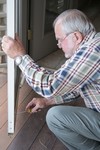Choosing the Right Weatherstripping
by Paul Bianchina
 Air infiltration — the movement of outside air into and out of your home — can account for a significant amount of heat loss, and the resulting air currents can make a home feel uncomfortably drafty.
Air infiltration — the movement of outside air into and out of your home — can account for a significant amount of heat loss, and the resulting air currents can make a home feel uncomfortably drafty.
When it comes to air infiltration some of the most common culprits are exterior doors, so a few weekend hours devoted to some new weatherstripping can have some pretty dramatic results.
Selecting the right weatherstripping
The type of weatherstripping to use depends somewhat on the type of door and frame you have, and also on how much time and effort you want to devote to the task.
The easiest and least expensive is foam, but, while it’s better than nothing, foam doesn’t form a tight, uniform seal and is also easily damaged. Foam weatherstripping comes in rolls of different widths and thicknesses, and is self-adhesive. It is applied to the inside edge of the door stop — the wood strips mounted on the door frame that the door closes against — and is designed to form a seal when the door closes against it. Select a foam that is the same width as the thickness of the door stop — typically 1/2 inch — and that is thick enough to close the gap between the door and the stop. Simply cut the foam to length with a pair of scissors, peel off the backing paper, and press it firmly against the door stop.
A better choice is a compression weatherstripping, which also fits between the door and the door stop to seal off air leaks, but has the advantage of being easier to adjust and considerably more durable. One type of compression weatherstripping is a semi-rigid, high-density foam strip that mounts into a slot in the door stop. Most new doors now come with this type of weatherstripping, and if you need to replace an existing piece on one of your doors, installation is simply a matter of cutting the replacement material to length and tucking the flange on the weatherstripping into the slot on the door stop. If your door does not currently have this type of weatherstripping, adding it would necessitate removing the door stops, cutting a slot along one edge, then reinstalling them.
Almost as effective — and easier to install — is vinyl bulb weatherstripping. Vinyl bulb weatherstripping has a tough, hollow strip of vinyl set in a rigid piece of aluminum, and a complete weatherstripping kit contains two long pieces for sides of the door, one short piece for the top, and all the necessary screws or nails for installation. To install, cut the short piece to fit between the door stops. Close the door, place the weatherstripping on the face of the door stop so that the vinyl bulb is slightly compressed against the face of the door, and nail it in place. Then simply repeat the process with the two side pieces.
To complete any door weatherstripping operation, don’t forget the gap between the bottom of the door and the wood or metal door sill. The simplest way to close this off is to use a door sweep, which is a flat aluminum strip with a piece of vinyl weatherstripping in one edge — simply screw the strip to the outer face of the door so that the vinyl makes contact with the sill and covers the gap.
More effective, however, is the door bottom, which is an L- or U-shaped aluminum strip with a curved vinyl insert on the bottom. The metal fits over the very bottom of the door, and is adjusted up or down so that the vinyl forms a complete seal against the sill. Installation may require removing the door and cutting a little bit off the bottom to accommodate the thickness of the metal and vinyl.
All of these types of weatherstripping are available at home centers, lumber yards, hardware stores and discount stores, and typically come with complete installation instructions and all of the necessary hardware for fast and easy installation.
Remodeling and repair questions? E-mail Paul at [email protected]. What’s your opinion? Leave your comments below or send a letter to the editor. To contact the writer, click the byline at the top of the story.
Copyright 2008 Inman News
See Paul Bianchina’s feature, Concrete Painting 101.
American Apartment Owners Association offers discounts on products and services related to your commercial housing investment including REAL ESTATE FORMS, tenant debt collection, tenant background checks, insurance and financing. Find out more at www.joinaaoa.org.
To subscribe to our blog, click here.















 Accessibility
Accessibility